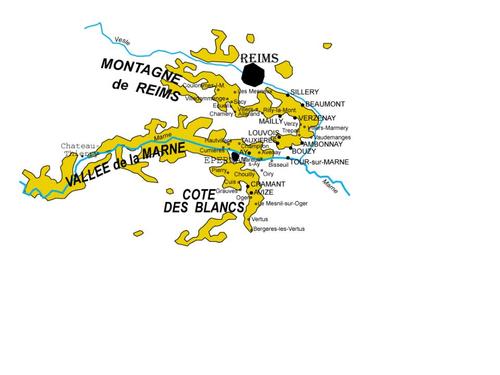Champagne: The Regions
Epernay, "capital" of the Champagne world
Bottles of rose Champagne in a riddling rack
The Montagne de Reims, a large massif situated north of the Marne River Valley and south of the capital city of Reims, is famed for its Pinot Noir plantings. Several of the villages are classified as Grands Crus under Champagne’s complex classification system, the top rating available to any vineyard. Fruit produced on the northward-facing slopes provides elegance and finesse, while the riper grapes grown on the southerly-facing slopes provide power and character. The Montagne’s Grands Crus villages include Ambonnay, Beaumont-Sur-Vesle, Bouzy, Louvois, Mailly-Champagne, Puisieulx, Sillery, Verzenay and Verzy.
Cellars cut into the living rock
The Cote des Bar is a large district located in the departement of the Aube, to the southeast of the main Champagne region of the Marne. A region of gently rolling terrain, it’s a touch warmer than the Marne, although it’s less centered on a major river system.
Aube wines are typically made primarily from Pinot Noir, with some Chardonnay and relatively little Meunier planted.
The Aube produces some 25% of Champagne’s grapes, and most growers in the district sell their fruit to the Grands Marques houses based in Reims and Epernay.
The Grand Cru village of Cramant in the Cote des Blancs
The Cote des Blancs, a curving ring of hills facing east and southeast just south of the Vallee de la Marne, is home base for the Chardonnay grape. Pure chalk underlies the soil of the region, and it produces wines of power, finesse and elegance. Home to the Grands Crus villages of Avize, Chouilly, Cremant, Le Mesnil-sur-Oger, Oger and Oiry, the region is famed primarily for its Blanc de Blancs Champagnes, made of 100% Chardonnay.
Champagne- the Cote de Sezanne is the purple line to the southwest. Map credit
The Abbey of Hautvillers- home of Dom Perignon
The Cote de Sezanne, to the southwest, is a geological extension of the Cote des Blancs. Dominated by chalky soils, it is mostly planted to Chardonnay and produces distinctive wines with a note of tropical fruit atop the classic elegance of Chard-based Champagnes.
The Vallee de la Marne, centered on the city of Epernay, is the heart of the Champagne district. The small city of Epernay, right on the river, is the historic center of the Champagne trade, and its Route des Champagnes is famed for the grand headquarters buildings of many of the most famous Grandes Marques, including Moet & Chandon, Bollinger, Pol Roger, Taittinger, Maison Salon, and many more.
The Grands Marques, the large negociant firms that dominate the Champagne business, are generally headquartered in Epernay or nearby Reims. These large producers represent the vast majority of the fine Champagne in trade, with annual production levels in the millions of bottles (Pol Roger 1.7 million bottles per year, Perrier-Jouet 3 million, Taittinger 5 million, Veuve Clicquot 10 million, Moet & Chandon clocking in at a whopping 32 million (including 5 million bottles of Dom Perignon annually). The vineyards are planted to Chardonnay, Pinot Noir and Pinot Meunier, with Meunier, resistant to mildew, dominant on the lower slopes that are subject to riverine mists.
In the smaller villages of the Vallee, a small number of fine growers continue to produce unique and individualistic Champagnes from their own vineyards.







